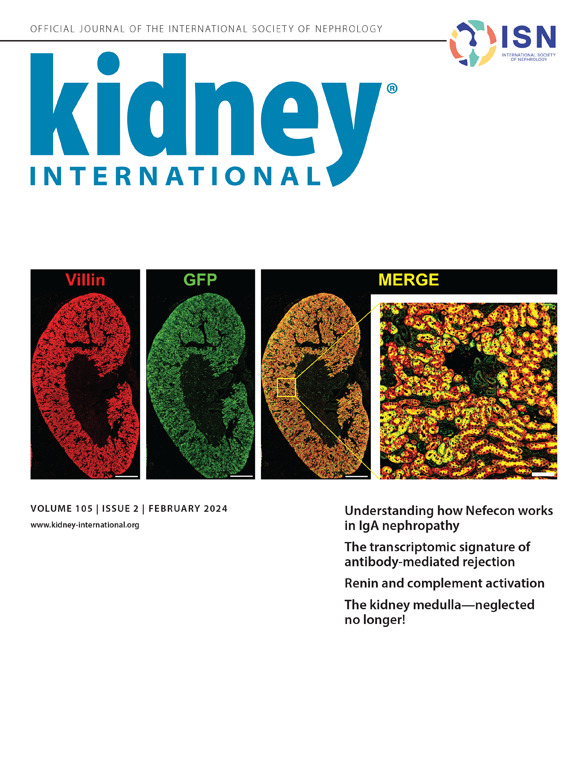A randomized controlled trial evaluated the efficacy and safety of apixaban for prevention of recurrent thrombosis after thrombectomy of hemodialysis vascular access
IF 14.8
1区 医学
Q1 UROLOGY & NEPHROLOGY
引用次数: 0
Abstract
Dialysis vascular access thrombosis poses a substantial challenge for individuals undergoing hemodialysis. The efficacy and safety of apixaban, a direct oral coagulation factor Xa inhibitor, in preventing recurrent access thrombosis have yet to be explored. Here, a multicenter randomized control study (NCT04489849) enrolled hemodialysis patients to evaluate this who underwent successful endovascular thrombectomy within 48 hours. Participants were assigned to standard care or standard care plus apixaban, 2.5 mg twice daily for three months. The trial design involved open-label administration, with independent adjudication of endpoints. The primary efficacy endpoint was recurrent access thrombosis within three months after thrombectomy. A total of 186 patients with well-balanced baseline characteristics were enrolled, 93 randomized to the apixaban group and 93 to the control group. The apixaban group demonstrated a significantly lower rate of access thrombosis at three months than the control group (24.0% vs. 40.8%; hazard ratio, 0.52 [95% confidence interval 0.31–0.88]), along with a significantly better primary patency failure rate (32.2% vs. 49.5%, 0.57 [0.36–0.91]). Safety outcomes showed comparable death rates and major bleeding incidents but significantly higher incidence of minor bleeding in the apixaban group (22.6% vs. 7.5%). The effect of apixaban did not show interaction in subgroups of different access types, antiplatelet usage, severity of comorbidities, or history of thrombosis. Thus, apixaban effectively reduced the risk of recurrent thrombosis in hemodialysis vascular access post-thrombectomy. Despite a minor increase in bleeding adverse effects, the net clinical benefit favors the use of apixaban in this context.

一项随机对照试验评估了阿哌沙班预防血液透析血管通路血栓切除术后血栓复发的有效性和安全性。
透析血管通路血栓是血液透析患者面临的一大挑战。阿哌沙班是一种直接口服凝血因子 Xa 抑制剂,其在预防复发性通路血栓形成方面的有效性和安全性尚有待探索。在此,一项多中心随机对照研究(NCT04489849)招募了血液透析患者,对在 48 小时内成功进行血管内血栓切除术的患者进行评估。参与者被分配到标准护理或标准护理加阿哌沙班(2.5 毫克,每天两次,持续三个月)。试验设计为开放标签给药,终点独立裁定。主要疗效终点是血栓切除术后三个月内再次出现入路血栓。共有186名基线特征均衡的患者参加了试验,其中93人被随机分配到阿哌沙班组,93人被随机分配到对照组。阿哌沙班组三个月内的入路血栓形成率明显低于对照组(24.0% 对 40.8%;危险比 0.52 [95% 置信区间 0.31-0.88]),初次通畅失败率也明显高于对照组(32.2% 对 49.5%,0.57 [0.36-0.91])。安全结果显示,阿哌沙班组的死亡率和大出血率相当,但轻微出血率明显更高(22.6% 对 7.5%)。阿哌沙班的效果在不同入路类型、抗血小板药物使用情况、合并症严重程度或血栓形成史的亚组中未显示交互作用。因此,阿哌沙班能有效降低血栓切除术后血液透析血管通路复发血栓的风险。尽管出血不良反应略有增加,但阿哌沙班的净临床获益有利于在这种情况下使用阿哌沙班。
本文章由计算机程序翻译,如有差异,请以英文原文为准。
求助全文
约1分钟内获得全文
求助全文
来源期刊

Kidney international
医学-泌尿学与肾脏学
CiteScore
23.30
自引率
3.10%
发文量
490
审稿时长
3-6 weeks
期刊介绍:
Kidney International (KI), the official journal of the International Society of Nephrology, is led by Dr. Pierre Ronco (Paris, France) and stands as one of nephrology's most cited and esteemed publications worldwide.
KI provides exceptional benefits for both readers and authors, featuring highly cited original articles, focused reviews, cutting-edge imaging techniques, and lively discussions on controversial topics.
The journal is dedicated to kidney research, serving researchers, clinical investigators, and practicing nephrologists.
 求助内容:
求助内容: 应助结果提醒方式:
应助结果提醒方式:


